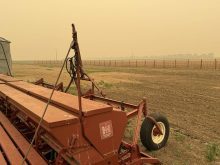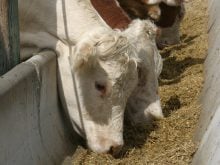The head of the Animal Health Emergency Management organization is reminding livestock producers to have a plan when dealing with emergent situations like the fires that have been rocking west-central Alberta and the Peace Country.
“There is always the element of being prepared but when the fire is happening near, it’s a little too late to be prepared,” said Mikki Shatosky, emergency management co-ordinator for AHEM.
“So really now it’s really about working with fire authorities, government, municipal-level governments — working closely with them to find out what you need to do, when you need to evacuate, if you need to evacuate and also identifying where you need to take your livestock.”
Read Also

Drones now used to assess wildlife crop damage in Saskatchewan
Wildlife damage in Saskatchewan crops is now assessed by drones and artificial intelligence.
That includes ensuring the evacuation location for livestock has adequate infrastructure and staff.
Alberta Beef Producers, agricultural societies and auction houses have been offering resources for livestock producers to relocate animals that must to moved away from danger.
The task is complicated by the timing of the fires, coming during calving season, which makes evacuation of cows extremely difficult.
Shatosky said close communications with a producer’s veterinarian can help deal with such situations.
While some cattle producers may knock down fences as a last resort to allow livestock a chance to escape encroaching fires, those actions come with risks.
“That’s scary because they could go onto a major highway and then your one incident turns into dealing with multiple incidents,” she said.
Such actions when it comes to hogs can also carry the risk of interaction with problem wild boar populations. Though, Shatosky said large hog operations are generally prepared to deal with emergencies.
Horse owners need to have a trailer ready or know where to get one in a hurry if they don’t have one of their own.
“They also should be training their horses to load,” she said. “It’s stressful conditions and if your horse isn’t conditioned to get onto those trailers, it could be a real problem getting them out of there.”
Shatosky said horses can act erratically in fires, even running into stables that are on fire because that is where they feel safest.
She said while all municipalities have emergency plans, not all of them incorporate livestock into them, which AHEM is advocating for them to do.
“It’s a gap right now. We need to make sure all of the municipalities that have livestock know where the livestock are,” she said. “On the producer side, it’s a hard one. When these things happen, they happen fast and you really need to respond at the last minute. Just knowing where to go to get the information where you can travel to, where is the fire going, is a huge thing.”
From the moment an individual decides to have livestock on their land, Shatosky said they must start thinking about how to deal with emergencies, whether it’s weather or disease related.
“We really need to start thinking ahead on how we deal with these animals,” she said, adding AHEM is hoping to convince the livestock industry, especially cattle, horse, goat and lamb producers, of the need.
Contact alex.mccuaig@producer.com
















